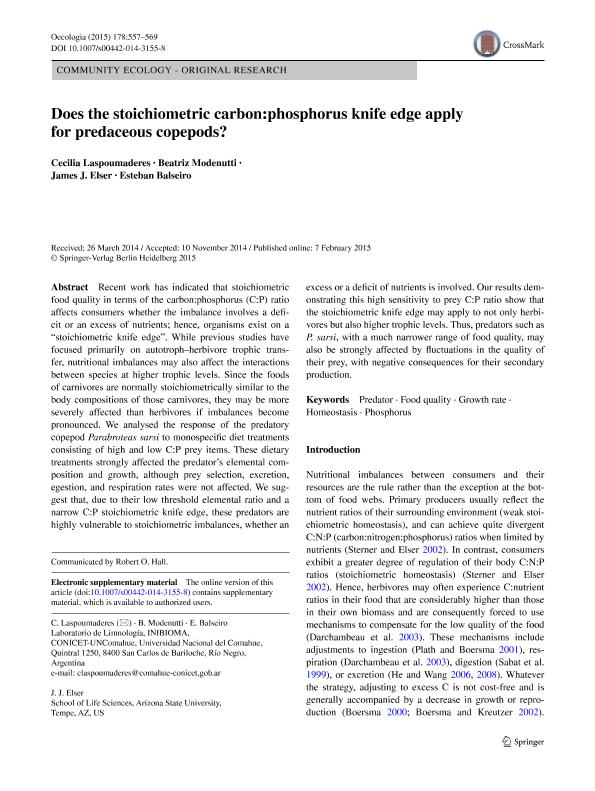Artículo
Does the stoichiometric carbon:phosphorus knife edge apply for predaceous copepods?
Fecha de publicación:
07/06/2015
Editorial:
Springer
Revista:
Oecologia
ISSN:
0029-8549
Idioma:
Inglés
Tipo de recurso:
Artículo publicado
Clasificación temática:
Resumen
Recent work has indicated that stoichiometric food quality in terms of the carbon:phosphorus (C:P) ratio affects consumers whether the imbalance involves a deficit or an excess of nutrients; hence, organisms exist on a “stoichiometric knife edge”. While previous studies have focused primarily on autotroph–herbivore trophic transfer, nutritional imbalances may also affect the interactions between species at higher trophic levels. Since the foods of carnivores are normally stoichiometrically similar to the body compositions of those carnivores, they may be more severely affected than herbivores if imbalances become pronounced. We analysed the response of the predatory copepod Parabroteas sarsi to monospecific diet treatments consisting of high and low C:P prey items. These dietary treatments strongly affected the predator’s elemental composition and growth, although prey selection, excretion, egestion, and respiration rates were not affected. We suggest that, due to their low threshold elemental ratio and a narrow C:P stoichiometric knife edge, these predators are highly vulnerable to stoichiometric imbalances, whether an excess or a deficit of nutrients is involved. Our results demonstrating this high sensitivity to prey C:P ratio show that the stoichiometric knife edge may apply to not only herbivores but also higher trophic levels. Thus, predators such as P. sarsi, with a much narrower range of food quality, may also be strongly affected by fluctuations in the quality of their prey, with negative consequences for their secondary production.
Archivos asociados
Licencia
Identificadores
Colecciones
Articulos(INIBIOMA)
Articulos de INST. DE INVEST.EN BIODIVERSIDAD Y MEDIOAMBIENTE
Articulos de INST. DE INVEST.EN BIODIVERSIDAD Y MEDIOAMBIENTE
Citación
Laspoumaderes, Cecilia; Modenutti, Beatriz Estela; Elser, James J.; Balseiro, Esteban Gabriel; Does the stoichiometric carbon:phosphorus knife edge apply for predaceous copepods?; Springer; Oecologia; 178; 2; 7-6-2015; 557-569
Compartir
Altmétricas




